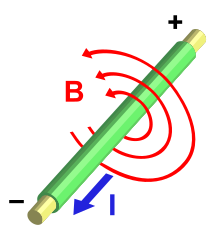Electrodynamics/Ampere's Law
In physics, Ampère's Circuital law, discovered by André-Marie Ampère, relates the circulating magnetic field in a closed loop to the electric current passing through the loop. It is the magnetic equivalent of Gauss's Law.
Original Ampère's Circuital law[edit | edit source]
In its original form, Ampère's Circuital law relates the magnetic field to its source, the current density :
[Ampere's Law]

Where
- is the closed line integral around contour (closed curve) C.
- is the magnetic field in amperes per metre.
- is an infinitesimal element (differential) of the contour C,
- is the current density (in amperes per square meter) through the surface S enclosed by contour C
- is a differential vector area element of surface S, with infinitesimally small magnitude and direction normal to surface S,
- is the current enclosed by the curve C, or strictly, the current that penetrates surface S.
Equivalently, the original equation in differential form is
The magnetic field in linear media, is related to the magnetic flux density (in teslas) by
where is the permeability of the medium (in henries per meter), which by definition is in free space.
The right hand grip rule is a mnemonic for visualizing the orientation of the magnetic field encircling the current density .
Corrected Ampère's Circuital law: the Ampère-Maxwell equation[edit | edit source]
James Clerk Maxwell conceived of displacement current as a polarization current in the dielectric vortex sea which he used to model the magnetic field hydrodynamically and mechanically. He added this displacement current to Ampère's Circuital law at equation (112) in his 1861 paper On Physical Lines of Force.
The generalized law, as corrected by Maxwell, takes the following integral form:
[Ampere-Maxwell Law]
where in linear media
is the displacement flux density (in coulombs per square meter).
This Ampère-Maxwell law can also be stated in differential form:
where the second term arises from the displacement current.
With the addition of the displacement current, Maxwell was able to postulate (correctly) that light was a form of electromagnetic wave. See Electromagnetic wave equation for a discussion on this important discovery. We will discuss all of Maxwell's laws in a later chapter.
Concept[edit | edit source]
The Equivalent to Gauss's Law for Electricity is Ampère's Law in Magnetism. It's a bit more complicated and you should know Gauss's before getting a grip on this one.
Imagine a wire with current flowing through it, the right hand screw rule says that there will be a magnetic field curling around the way your fingers do with your thumb pointing the direction of conventional current.
You can predict that the magnetic field will be curling around proportionally to the current flowing. Ampère's Law will tell you how.
Sketch Proof[edit | edit source]
Imagine an infinite wire going into the page with a current I. The Biot-Savart law, says that the Magnetic Field is given by an infinite wire as:
Now take the integral of B around the wire counterclockwise in a circular path l:
Differential Form of Ampère's Law[edit | edit source]
Above is the Integral form of Ampère's Law, like Gauss's Law, there is also a differential form of Ampère's.
Now taking J as the volume current density and using Stoke's Theorem we get:
And so:
You may want to look up Cross Products
References[edit | edit source]
- Introduction to ElectroDynamics, Third Edition by David J. Griffiths, Prentice Hall, 1999. ISBN 013805326X



















